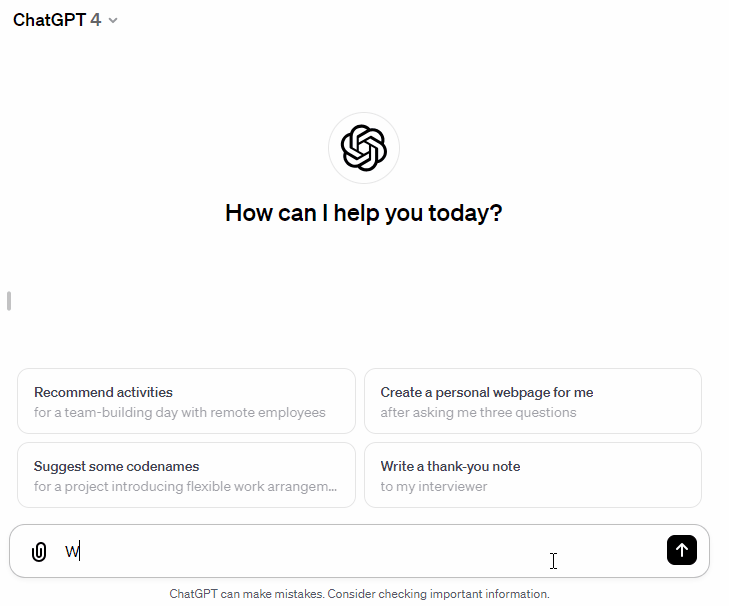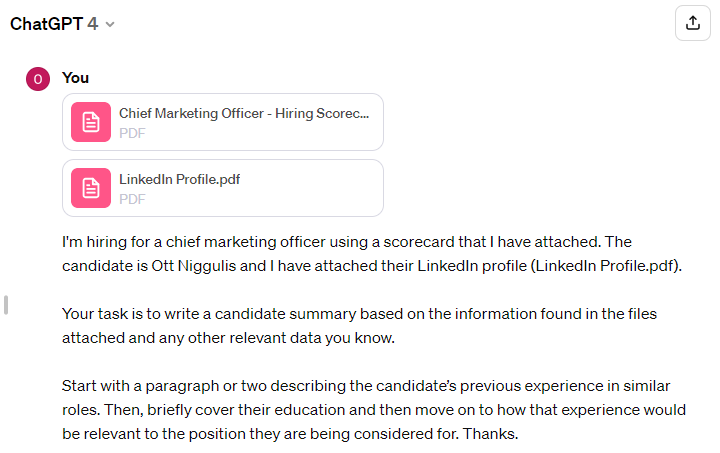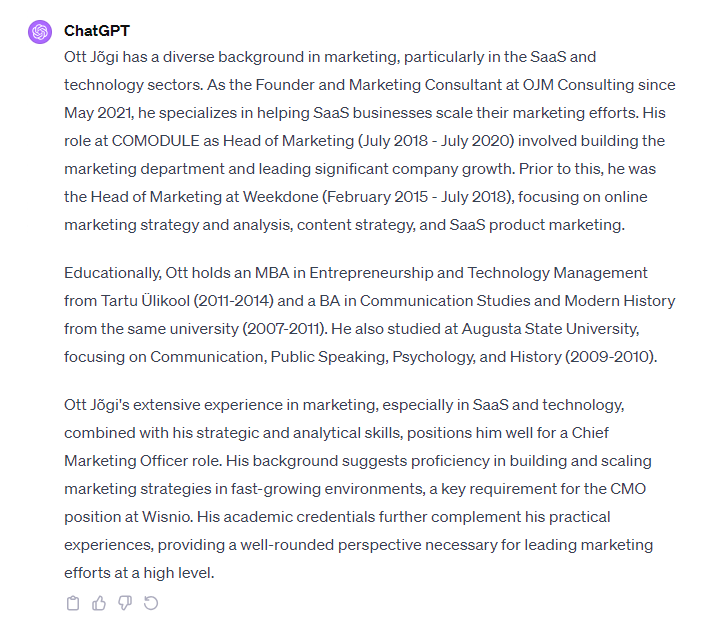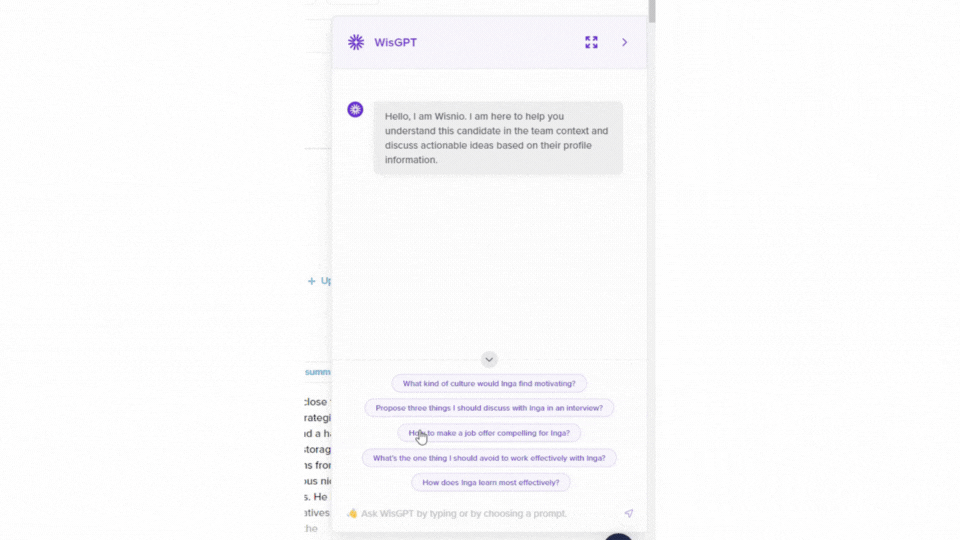Writing candidate summary with AI in 5 minutes
Ott Niggulis
Writing candidate summaries is an important, yet mundane and time-consuming part of hiring. A well-written summary can make a candidate stand out, while a poorly written one risks them being overlooked.
As with job analysis, AI tools like ChatGPT, Google's Gemini, Anthropic's Claude and others offer incredible potential to make the job easier, but effectively utilising them requires more than a simple 'summarise' command. They do not have out-of-the-box access to candidate-specific information found on candidates’s CVs, LinkedIn profiles, and personal call/interview notes.
This doesn’t necessarily mean that you can not use AI to write detailed candidate summaries, but rather that you have to add relevant context and factual information to get the desired results.
This article is part of a series of articles on the benefits of Generative AI for executive search and leadership assessment professionals. Part 1, Job Analysis, is available HERE.

Give the AI a blueprint to follow
Everyone has their own style of how to write candidate summaries. Over the years you have come to develop a blueprint on what to include and where, what words to use, and how to format it all.
For example, you always start with a paragraph or two describing the candidate’s previous experience in similar roles. Then briefly cover their education and then move on to how that experience would be relevant to the position they are being considered for. Or you may start by explaining how the candidate’s experience matches the requirements of the job.
With AI, you start by describing what it is you’re trying to achieve. Describe the format, what words to use, the tone of voice, what to concentrate on, etc. For clarity, you can include example summaries for better understanding.
Next, you add information about the role that the candidates are being considered for. This helps the AI understand what aspects of the candidate's profile are most relevant. For help with job analysis, check out our job analysis with AI article.
And finally, you add the crucial candidate context or specific information about the candidate.
This can include:
- Candidate CV;
LinkedIn profile PDF (direct LinkedIn access is blocked for most AI chatbots);
Interview and/or call notes;
Assessment results (personality, skills, etc)
Data from reference checks
Candidate cover letter
Etc.
*For best results, prioritise high-quality data sources like detailed CVs and interview notes. Supplementing them with any additional candidate information further enhances accuracy.
Similar to job analysis, the information you provide needs to be clear and detailed enough for the AI to analyse and write high-quality summaries. The more detailed the input is, the better the output is likely to be.
For best results, experiment with different ways to provide information to the AI and see what works best for your needs. This could include testing different data formats and prompts (instructions).
It’s also important to note that no AI is perfect. It can make mistakes, and it sometimes struggles with capturing the subtleties of position requirements and a candidate's profile, missing nuanced skills or cultural fit aspects. Thus, AI-generated content should always be checked for validity by humans.
Looking for Hiring Scorecards? Click here to check out our free scorecard library!
Example

Example ChatGPT prompt for writing candidate summaries
As an example, I asked ChatGPT to write a candidate summary using a Wisnio hiring scorecard and the candidate's LinkedIn profile in PDF format. In this particular case, the candidate had a detailed LinkedIn profile, and thus I did not add any additional content.
I added both the hiring scorecard and the candidate’s PDF to ChatGPT and asked it to write a candidate summary using a template.
The template was to start with a paragraph describing the candidate’s previous experience in similar roles. Then, briefly cover their education and finish off with how that experience would be relevant to the position they are being considered for.
This was the summary I got:

Example candidate summary
If you are not happy with the result, you can ask the AI to tweak it as per your requirements. You can ask it to make it longer, to emphasise certain points from the CV or the scorecard, add or remove a section, change the tone of voice, etc.
Next, let's look at how Tõnis Arro, an executive search professional with 30+ years of experience, has integrated AI into writing on-point candidate summaries.
“First, I specifically prompt the AI to make it 100 words and point out the most important figures and facts (e.g. "Worked X years in sales manager roles in companies Y, Z and W"; "Achieved three times growth in B2B sales in 2 years," etc).
My summaries of the candidates are usually divided into three parts:
Career summary based on the candidate's LinkedIn profile, CV, and my notes from interviews with the candidate.
Summary of the candidate's assessment result. I use Wisnio assessments consisting of competencies, values, and personality.
Summary of candidate's fit with the team - how well aligned with values and what diversity the candidate potentially brings to the team with their personality and competencies.
As the assessments happen on the Wisnio platform, I use the included WisGPT for writing the summaries. The main difference from other generative AI tools is that WisGPT has access to candidate-specific assessment results, which include hundreds of additional data points about the candidate.”
Conclusions

AI offers the promise of faster, more streamlined candidate summaries - freeing up valuable consultants' and partners' time for other high-value activities.
But, to unlock AI's full potential, it’s not enough to simply instruct an AI to write a concise candidate summary. You need to provide it with a clear template, feed it rich data (CVs, interview notes, assessment results), and be ready to step in whenever it misinterprets information.
To harness the full potential of AI without the hassle, consider WisGPT. With direct access to candidate-specific talent data and our proprietary training, WisGPT delivers hyper-personalised summaries and answers any questions you have about the candidate, allowing you to focus on the truly strategic aspects of hiring.